Lothringen , or Lorraine, is a region of northeastern France.
Lothringen may also refer to:

Admiral Scheer[ˌatmiˈʁaːl ʃeːɐ̯] was a Deutschland-class heavy cruiser which served with the Kriegsmarine of Nazi Germany during World War II. The vessel was named after Admiral Reinhard Scheer, German commander in the Battle of Jutland. She was laid down at the Reichsmarinewerft shipyard in Wilhelmshaven in June 1931 and completed by November 1934. Originally classified as an armored ship (Panzerschiff) by the Reichsmarine, in February 1940 the Germans reclassified the remaining two ships of this class as heavy cruisers.

Operation Rheinübung was the sortie into the Atlantic by the new German battleship Bismarck and heavy cruiser Prinz Eugen on 18–27 May 1941, during World War II. This operation to block Allied shipping to the United Kingdom culminated with the sinking of Bismarck.

SMS Bayern was the lead ship of the Bayern class of battleships in the German Kaiserliche Marine. The vessel was launched in February 1915 and entered service in July 1916, too late to take part in the Battle of Jutland. Her main armament consisted of eight 38 cm (15 in) guns in four turrets, which was a significant improvement over the preceding König's ten 30.5 cm (12 inch) guns. The ship was to have formed the nucleus for a fourth battle squadron in the High Seas Fleet, along with three of her sister ships. Of the other ships only one—Baden—was completed; the other two were canceled later in the war when production requirements shifted to U-boat construction.
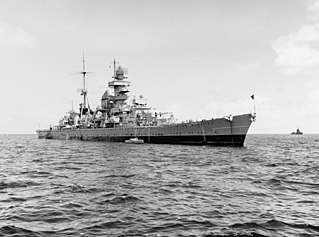
Prinz Eugen was an Admiral Hipper-class heavy cruiser, the third of a class of five vessels. She served with Nazi Germany's Kriegsmarine during World War II. The ship was laid down in April 1936, launched in August 1938, and entered service after the outbreak of war, in August 1940. She was named after Prince Eugene of Savoy, an 18th-century general in the service of Austria. She was armed with a main battery of eight 20.3 cm (8 in) guns and, although nominally under the 10,000-long-ton (10,160 t) limit set by the Anglo-German Naval Agreement, actually displaced over 16,000 long tons (16,257 t).
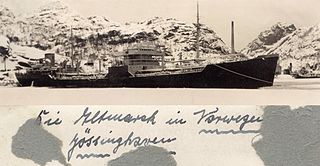
Altmark was a German oil tanker and supply vessel, one of five of a class built between 1937 and 1939. She is best known for her support of the German commerce raider, the "pocket battleship" Admiral Graf Spee and her subsequent involvement in the "Altmark Incident". In 1940 she was renamed the Uckermark and used as supply tanker for the battleships Scharnhorst and Gneisenau during Operation Berlin before sailing to Japan on September 1942 as a blockade breaker.

HMS Dunedin was a Danae-class light cruiser of the Royal Navy, pennant number D93. She was launched from the yards of Armstrong Whitworth, Newcastle-on-Tyne on 19 November 1918 and commissioned on 13 September 1919. She has been the only ship of the Royal Navy to bear the name Dunedin.
Jersey is a heavily fortified island with coastal fortifications that date from different periods such as the English Civil War, the Napoleonic Wars, and Nazi Germany's occupation of the Channel Islands. The fortifications include castles, forts, towers, Martello towers, artillery batteries, and seawalls. Not infrequently, fortifications from one period are built on the site of earlier fortifications, or very near them, geography having remained the same even when firepower increased.
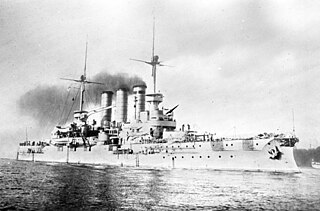
SMS Braunschweig was the first of five pre-dreadnought battleships of the Braunschweig class built for the German Kaiserliche Marine. She was laid down in October 1901, launched in December 1902, and commissioned in October 1904. She was named after the Duchy of Brunswick. The ship was armed with a battery of four 28 cm (11 in) guns and had a top speed of 18 knots. Like all other pre-dreadnoughts built at the turn of the century, Braunschweig was quickly made obsolete by the launching of the revolutionary HMS Dreadnought in 1906; as a result, her career as a front-line battleship was cut short.

The Braunschweig-class battleships were a group of five pre-dreadnought battleships of the German Kaiserliche Marine built in the early 1900s. They were the first class of battleships authorized under the Second Naval Law, a major naval expansion program. The class comprised five ships—Braunschweig, Elsass, Hessen, Preussen, and Lothringen—and they were an improvement over the preceding Wittelsbach class. The Braunschweigs mounted a more powerful armament of 28 cm (11 in) and 17 cm (6.7 in) guns. Less than two years after the first members of the class entered service, the ships were rendered obsolescent by the British all-big-gun battleship Dreadnought, which curtailed their careers.

The Battle of the Caribbean refers to a naval campaign waged during World War II that was part of the Battle of the Atlantic, from 1941 to 1945. German U-boats and Italian submarines attempted to disrupt the Allied supply of oil and other material. They sank shipping in the Caribbean Sea and the Gulf of Mexico and attacked coastal targets in the Antilles. Improved Allied anti-submarine warfare eventually drove the Axis submarines out of the Caribbean region.

The dreadnought was the predominant type of battleship in the early 20th century. The first of the kind, the Royal Navy's HMS Dreadnought, had such an impact when launched in 1906 that similar battleships built after her were referred to as "dreadnoughts", and earlier battleships became known as pre-dreadnoughts. Her design had two revolutionary features: an "all-big-gun" armament scheme, with an unprecedented number of heavy-calibre guns, and steam turbine propulsion. As dreadnoughts became a crucial symbol of national power, the arrival of these new warships renewed the naval arms race between the United Kingdom and Germany. Dreadnought races sprang up around the world, including in South America, lasting up to the beginning of World War I. Successive designs increased rapidly in size and made use of improvements in armament, armour and propulsion throughout the dreadnought era. Within five years, new battleships outclassed Dreadnought herself. These more powerful vessels were known as "super-dreadnoughts". Most of the original dreadnoughts were scrapped after the end of World War I under the terms of the Washington Naval Treaty, but many of the newer super-dreadnoughts continued serving throughout World War II.

SMS Elsass was the second of five pre-dreadnought battleships of the Braunschweig class in the German Imperial Navy. She was laid down in May 1901, launched in May 1903, and commissioned in November 1904, though an accident during sea trials delayed her completion until May 1905. She was named for the German province of Elsass, now the French region of Alsace. Her sister ships were Braunschweig, Hessen, Preussen and Lothringen. The ship was armed with a battery of four 28 cm (11 in) guns and had a top speed of 18 knots. Like all other pre-dreadnoughts built at the turn of the century, Elsass was quickly made obsolete by the launching of the revolutionary HMS Dreadnought in 1906; as a result, her career as a frontline battleship was cut short.
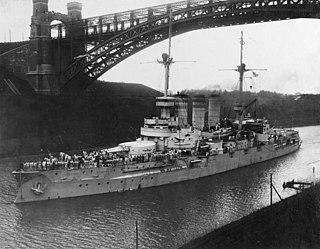
SMS Lothringen was the last of five pre-dreadnought battleships of the Braunschweig class, built for the German Kaiserliche Marine. She was laid down in December 1902, was launched in May 1904, and was commissioned in May 1906. She was named for the then-German province of Lothringen. The ship was armed with a battery of four 28 cm (11 in) guns and had a top speed of 18 knots. Like all other pre-dreadnoughts built around the turn of the century, Lothringen was quickly made obsolete by the launching of the revolutionary HMS Dreadnought in 1906; as a result, her career as a front-line battleship was cut short.
Georgia usually refers to:

Scharnhorst was a German capital ship, alternatively described as a battleship or battlecruiser, of Nazi Germany's Kriegsmarine. She was the lead ship of her class, which included her sister ship Gneisenau. The ship was built at the Kriegsmarinewerft dockyard in Wilhelmshaven; she was laid down on 15 June 1935 and launched a year and four months later on 3 October 1936. Completed in January 1939, the ship was armed with a main battery of nine 28 cm (11 in) C/34 guns in three triple turrets. Plans to replace these weapons with six 38 cm (15 in) SK C/34 guns in twin turrets were never carried out.

Gneisenau was a German capital ship, alternatively described as a battleship and battlecruiser, of Nazi Germany's Kriegsmarine. She was the second vessel of her class, which included her sister ship, Scharnhorst. The ship was built at the Deutsche Werke dockyard in Kiel; she was laid down on 6 May 1935 and launched on 8 December 1936. Completed in May 1938, the ship was armed with a main battery of nine 28 cm (11 in) C/34 guns in three triple turrets. Plans were approved, once construction had started, to replace these weapons with six 38 cm (15 in) SK C/34 guns in twin turrets, but as this would involve a lot of redesign, construction continued with the lower calibre guns. The intent was to make the upgrade in the winter of 1940–41 – but the outbreak of World War II stopped this.

Battery Lothringen was a World War II coastal artillery battery in Saint Brélade, Jersey, named after the SMS Lothringen, and constructed by Organisation Todt for the Wehrmacht during the Occupation of the Channel Islands. The first installations were completed in 1941, around the same time as the completion of the nearby Battery Moltke, in St. Ouen.

The Channel Islands Occupation Society (CIOS) is a voluntary organisation that seeks to study all aspects of the German occupation of the Channel Islands and to raise awareness and educate the public about the occupation during the Second World War. There are two branches, one in Jersey and the other in Guernsey, that take turns in publishing the Channel Islands Occupation Review. The CIOS manages many German fortifications and archives on both islands.
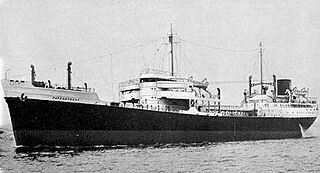
Lothringen was an oil tanker ordered for Dutch shipowner Phs. Van Ommeren under the name Papendrecht in Rotterdam. On 16 May 1940, the Kriegsmarine seized her when the ship was still under construction and she was renamed Lothringen. She was commissioned on 23 January 1941. The ship became the property of Erste Deutsche Walfang-Gesellschaft of Hamburg who converted her into a support ship for naval operations by the German battleship Bismarck and cruiser Prinz Eugen in the Atlantic. On 15 June 1941, Lothringen was captured by the British light cruiser HMS Dunedin and taken into service of the Admiralty, crewed by the Royal Fleet Auxiliary. It was renamed Empire Salvage in 1941 and served the Allies for the remainder of the war. After the war, it was handed back to its owners.